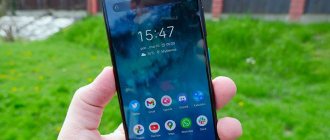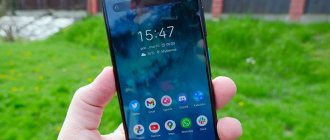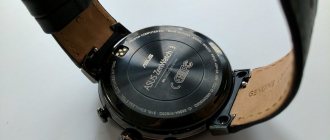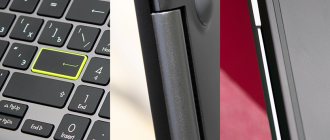Equipment
Inside the box we find a standard set of accessories:
- Micro USB cable
- wired headset
- charger 5 volts and 2 amps (not fast charging)
- and the smartphone itself
There was no case in the box, so protecting the device is entirely up to the user. Although the smartphone is well assembled, the materials are of high quality and do not scratch - you can carry it without a case.
Hardware
It's a little disappointing to have a MicroUSB port instead of USB Type-C. For most people this is not a problem, but after all, this is a 2022 smartphone!
SIM card tray allows you to install two SIM cards and a microSD card at the same time. This is a nice addition for a budget phone, but only one can work on 4G networks, while the other is limited to 3G.
Design and display
Here's the first thing you need to know for those looking at the Zenfone Max Pro (M1). We have a real shovel in front of us. It’s impossible to call a smartphone a miniature one.
But here is a thin body. The device is pleasant to use and still feels great in the hand.
In itself, the thickness of 8.45 mm is far from a record, but as soon as you find out that a huge battery for 5 thousand “mach” is hidden inside, your attitude changes, you will agree.
Another plus of such impressive dimensions is the huge, 6-inch display, elongated in height. In addition, its corners are neatly rounded just like the Google Pixel 2 XL. By the way, given the clean and fast Android 8.1.0, the user experience is slightly reminiscent of Google's flagship. It's like holding a Pixel 2 XL Lite or something like that.
You can’t find fault with the quality of the IPS matrix itself. Color rendition, brightness, viewing angles - everything is at a very decent level. And the absence of an air gap makes the screen look like it was printed on glass. This makes operating your smartphone extremely pleasant.
Yes, there are fairly wide side frames, a chin and a forehead, but they are saved by the black color. The latter does not distract from what is happening on the display and soon you stop noticing the bezel around the screen altogether.
The appearance of the back side is quite controversial. The metal back was placed in a plastic edging. Yes, metal transmits the antenna signal under the body worse, but usually plastic inserts are placed on the top and bottom. And here they run along the entire perimeter.
However, what confused me more than anything else was the cameras. The vertical module, although it practically does not protrude above the body, is integrated into the design very strangely. I’m sure this moment could have been handled more elegantly, but the guys from Asus apparently didn’t bother. Well, or they thought it was beautiful (I hope they just didn’t bother).
Here, on the back side, there is a fingerprint scanner. In general, it is not difficult to reach it, but there are complaints about the speed of its work. The sensor is very average in speed and unlocks the device in 1-2 seconds. By modern standards this is quite slow.
All connectors (audio output, Micro USB and speaker) are located at the bottom. In my opinion, this is their most convenient location. A protruding charging or headphone cable will never get in the way. There is nothing on the top end other than the microphone hole. The infrared port was not delivered, but God bless him.
Specifications Asus Zenfone Max Pro (M1) ZB602KL
- Qualcomm Snapdragon 636 processor (8 Kryo 260 cores, 1.8 GHz, 14 nm)
- Adreno 509 graphics
- RAM 3 (after reboot free 1.6 GB), 4 or 6 GB GB LPDDR4X
- 32 data storage (18.64 GB available) or 64 GB eMMC 5.1
- Micro SD memory cards available (independent slot)
- 6-inch IPS display 18:9, 2160 x 1080 (402 ppi density), 85% NTSC, 450 nits brightness, 1500 to 1 contrast ratio
- main camera 13 MP (f/2.2, focal length 25 mm, phase detection autofocus, 4K+ video recording) and 5 MP
- front camera 8 MP (f/2.2, 26 mm, viewing angle 85 degrees, portrait mode)
- battery 5,000 mAh
- OS Android 8.1.0 (no shell)
- sensors: accelerometer, light and distance sensor, fingerprint scanner, compass, gyroscope
- Connectors: Micro USB (OTG works) and audio output
- Dimensions: 159 x 76 x 8.45 mm
- weight 180 g
- colors: silver and dark blue (we only sell the first one)
Wireless capabilities:
- 4G, Wi-Fi (802.11 b/g/n 2.4 GHz), FM radio, Bluetooth 5.0 (!), NFC
- support for two SIM cards (separate slots)
- Navigation: GPS, Glonass, Beidou
In general, Asus Zenfone Max Pro (M1) has many modifications. You can choose a memory ratio from 32 to 64 GB, as well as RAM within 3 - 4 GB. In addition, in the wild (not in Russia) there is another model that received 8 gigs of RAM and a slightly upgraded main camera of 16 megapixels (f/2.0).
Asus, as always, has long names that are impossible to remember. And even if the smartphone is successful, it is simply impossible to associate it with this “Eysus-zenfon-max-pro-em-one-ze-be-six-hundred-two-ka-el.”
Maybe in Taiwan everything is ok with such names, but in Russia and throughout the world all companies try not to bother users with unnecessary information. But not Asus. Why? Don't know.
Scolded? It's time to praise, because there is something to be said for.
Firstly, here we have two slots for Nano SIM cards and a separate tray for Micro SD memory. As a result, the user does not feel deprived of either memory or communication. Definitely thank you for this!
But that's not all.
For example, the device is equipped with a Bluetooth 5.0 module. Unlike Xiaomi, which also installs modern processors in its devices, Asus did not programmatically downgrade the Bluetooth version. The fifth generation gives us better power consumption and a wide data transmission channel. Right now this is not needed, but in the future, with the advent of supported accessories, it will definitely come in handy.
In addition, the device was equipped with an NFC module.
Therefore, we download Google Pay, link the card and go to the store to pay for purchases using a contactless method. However, there is one caveat here - NFC worked for me every now and then. In one store everything can go without problems, but after 10 minutes in the next Google Pay may no longer work. This happened to me when I was waiting in line at the checkout for 3 minutes and as a result the stocked item had to be canceled, and I went to the car to get my card.
However, I tested an engineering sample; this should not be a problem in commercial devices.
Battery
The ASUS budget model has a battery with a more than impressive capacity of 4000 mAh, which fully explains the thickness of the model’s body. Thanks to the battery, the smartphone can work up to 36 hours in talk mode and up to 16 hours in online video playback mode. We thoroughly tested the Max (M1) over several days and found the performance to be accurate. With one exception. In video viewing mode, we were unable to achieve 16 hours of battery life. The device only worked for 11 hours. In everyday operation, the Max (M1) is impressive in its autonomy - many will only have to charge their smartphone once every two days.
Performance
In general, future owners of Zenfone Max Pro (M1) are lucky. Thanks to the Qualcomm Snapdragon 636 processor, the device will be relevant for at least a couple of years. The predecessor, QS 625, is still installed on newly released devices and feels great. Although the “stone” was released already in 2016. In addition, the new 636th snap is one and a half times faster, which has a positive effect on performance.
The system works quickly and without brakes. It is very rare and far from always possible to notice random freezes when scrolling through, for example, the list of installed applications. Otherwise there are no complaints.
You can even play games with the Max Pro (M1). For example, you can play PUBG Mobile without any problems even on high graphics settings. There are practically no brakes or lags, it’s comfortable to play.
Cameras
But everything was going so well, huh? Unfortunately, in terms of photography, our hero is far from the best offer on the market.
The main camera of the Asus Zenfone Max Pro (M1) is below average here and shoots accordingly.
Personally, there were a few things that bothered me here. The first is distortion in the corners. Take a closer look at any photo and you will see how everything is floating in the left, upper or opposite corner.
The second unpleasant nuance is oversharing. Even without zooming in, it’s noticeable that most photos have a ton of extra noise. The algorithms that are supposed to clean up all this mess don’t work here.
And the third critical point is the strange work of the exposition. Below are a couple of the most critical examples.
In the left photo everything is dim, although it is clear that the photo was taken on a sunny day. The second frame is so bright that it burns out your eyes. But there is no necessary, golden mean.
At night everything is generally bad. It takes about the fifth or sixth time to take an unblurred frame. And even if you have iron hands, the final photo will turn out with poor detail and continuous soap throughout the frame.
I really hope that they will still have time to finish the camera. In the meantime, those interested can experiment with installing the Camera HDR+ application from Google (not always installed and not all versions).
By the way, here is a link to the archive with all the examples without resizing for self-study on your computer.
Since we have two cameras here, the smartphone can blur the background. At least on paper this is so, because in reality everything looks very artificial and ugly.
I definitely wouldn’t use portrait mode on the Asus Zenfone Max Pro M1, although undemanding users will be satisfied with this quality.
Unfortunately, the front camera also cannot boast of anything outstanding. The abundant noise throughout the frame and inadequate white balance are frustrating. But the background blur, despite the fact that we have only one module here, was pleasing.
The front camera also has its own LED flash. However, it must be used with extreme caution.
Video recording
The device can record enhanced Ultra HD video. It's called 4K DCI and boasts a resolution of 4096 x 2160 pixels. Let me remind you that standard 4K has a resolution of 3840 x 2160 pixels, and the M1 can also shoot such video.
The picture quality is high, there is slight looseness with small artifacts, but overall it is not critical. On a smartphone, the videos look absolutely fiery.
I only disliked two points. The first is that there is no optical stabilization, even during Full HD recording. Without it, shaking of the hands is visible and you need to train so that there is no tremor that is critical for the quality of the video.
Secondly, there is no way to tap on the screen on the desired object during video shooting and refocus on it. Only the automation itself is responsible for the focus, so it will work as it pleases.
⇡#Autonomous work
The increased diagonal of the display in terms of power consumption is partly compensated by the organic LED matrix, which made it possible not to increase the battery capacity, but to transfer here the same one that was in Zenfone 6 - 19 Wh (5000 mAh, 3.8 V). Even if you leave the display of notifications and clock on the locked screen turned on (Always-On Display) and moderately intensive use of Zenfone 7 Pro, it confidently lives all day. ASUS keeps this bar in each of its smartphones.
In our traditional test with Full HD video playback at maximum brightness, with the wireless connection turned on and updates in effect, the Zenfone 7 Pro lasted almost 13 hours - an above-average result.
And, hurray, now the Zenphone comes with fast charging. Using a 30 W adapter, you can charge the gadget in an hour and a half. But you don’t have to do this - still, such intensity leads to faster battery wear, and Zenfone 7 Pro offers options for slow charging, scheduled charging and charging limit (if you don’t charge to the maximum each time, the battery will last longer). When set to overnight charging, these options seem invaluable. The smartphone, by the way, tracks how you charge it and demonstrates this in the tab dedicated to battery care. Wireless charging is not supported.
Software
The device runs on pure Android 8.1.0 with an upcoming update to the next OS revisions. And of course, the bare system, in the form in which Google intended it, is wonderful.
There is no third-party software except for Facebook and Instagram installed out of the box.
Of the nuances. Personally, I was somewhat upset by the hefty strip under the on-screen buttons at the bottom. Yes, the display here is rather large, but the keys eat up a very decent amount of screen area. I would like to use navigation gestures (not yet available in Android), or provide the ability to somehow hide this panel.
However, after a week I got used to the navigation bar. Fortunately, a 6-inch screen is already enough for everything you need.
Software
The Asus Zenfone 7 Pro runs on the ZenUI 7 shell, which is not much different from pure Android. However, the company has added a number of useful functions and tools here to make interacting with your smartphone easier.
One of them is smart key customization: for example, you can reassign the power button to several other actions. Through it, you can open applications, system settings or Google Assistant - by double-clicking or holding.
The Game Genie function from ROG Phone has also migrated to the model. This is a convenient set of tools for gamers: it allows you to pause notifications, change brightness, start broadcasting or record gameplay. The mode is launched via a swipe to the left and will certainly appeal to fans of mobile games.
There are also opportunities to customize the interface yourself. You can change the theme, icon shape, and even the shutdown menu. Not to say that these are some huge software changes, but they turn out to be convenient.
Sound
The speaker here takes the rap for the external sound alone. It is very loud, so you can only miss a call at a rock concert or Formula 1 race.
The quality of the speaker is average. As expected, there is no bass or even a hint of it, so for more or less high-quality sound, you should reduce the volume by 70% - it will still be enough.
The sound in the headphones is very decent - on par with all other modern devices. The main thing is to choose high-quality “ears” and under no circumstances use the included headset. If it seemed to you that she was normal, then know that it seemed to you.
Screen
| Matrix | S-IPS |
| Diagonal | 6″ |
| Permission | 1080×2160 |
| PPI | 402 |
| Multi-touch | 10 |
| Max white brightness | 370 cd/m2 |
| Min white brightness | 4.5 cd/m2 |
| Contrast | 1170:1 |
| Color temp. | 6800-8500K |
| Gloves | No |
The screen is cool. And the resolution is high, and there are no strange cutouts, and the brightness is good, and there is an oleophobic coating. I can only grumble about the fact that it doesn’t react to gloves.
Autonomy
Perhaps this is one of the most important advantages of a smartphone. It would not be amiss to repeat that a 5,000 mAh battery was placed inside a fairly thin 8.5 mm case. Considering that the chipset is not the most power-hungry on the market (QS 636 is created using a 14 nm process technology), the autonomy is really pleasing.
Two full days of normal use is the absolute norm for our device! The battery here is simply indestructible.
My smartphone easily worked for 2.5 days, so I even played it safe with the withdrawal. At the same time, the screen operating time was 7 hours!
I haven't seen such results for a long time. Maybe since the Xiaomi Mi Max 2 test last year. However, it was a hefty phablet, and our hero is still a smartphone, albeit with a large screen.
Full charging time from the supplied power supply (5V and 2A) is 3 hours. A bit much, of course, but this procedure does not need to be done often.











